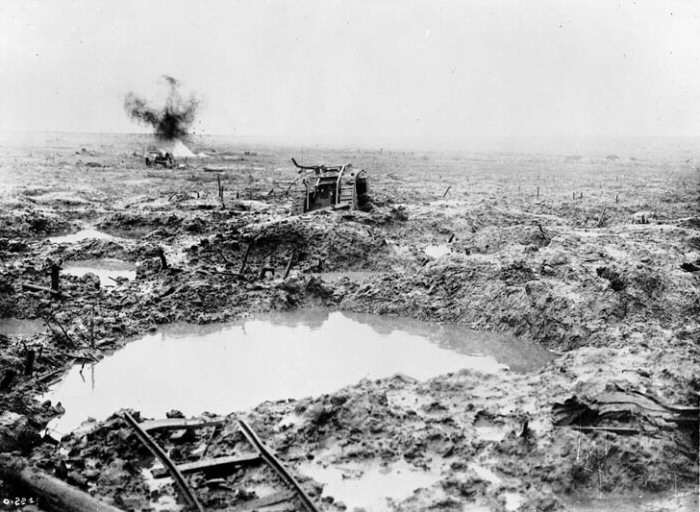
The destroyed landscape of the Passchendaele battlefield. Image: Library and Archives, Canada
W. FENEMORE
W Fenemore was a gunner with “B” Battery of the 74th Brigade of the Royal Field Artillery. There is no information as to his relatives in Sulgrave. He died on the 26th July 1917 and is buried in Bleuet Farm Cemetery near the village of Elverdinge in Belgium. From the date of his death and the location of the cemetery it seems likely that he was a casualty in the Third Battle of Ypres.
Meticulously planned, the Third Battle of Ypres was launched towards the end of July 1917 and continued until the fall of Passchendaele village on 6 November. The offensive resulted in gains for the Allies but was by no means the breakthrough Sir Douglas Haig intended, and such gains as were made came at great cost in human terms.
Today commonly referred to simply as ‘Passchendaele’, the tactics employed at the Third Battle of Ypres are as controversial as those executed at the Battle of the Somme a little over a year earlier, and was the final great battle of attrition of the war.
As a second stage of the action, General Sir Hubert Gough was put in charge of the attacks to secure the Gheluvelt Plateau which overlooked Ypres. Huge numbers of guns were moved into the area and started a four-day bombardment (was this perhaps the action that Gunner Fenemore took part in), but the Germans recognised the sign of an impending offensive, and moved more troops in to reinforce the defences.
In July the Germans used mustard gas for the first time. It attacked sensitive parts of the body, caused blistering, damage to the lungs and inflammation of the eyes, causing blindness (sometimes temporary) and great pain.
One problem in carrying the offensive forward was the Yser canal, but this was taken on July 27 when the Allies found the German trenches empty. Four days later, the offensive proper opened with a major action at Pilkem ridge, with Allied gains of up to 2000 yards. The Allies suffered about thirty-two thousand casualties — killed, wounded or missing — in this one action.
Ground conditions during the whole Ypres-Passchendaele action were atrocious. Continuous shelling destroyed drainage canals in the area, and unseasonable heavy rain turned the whole area into a sea of mud and water-filled shell-craters. The troops walked up to the front over paths made of duckboards laid across the mud, often carrying up to one hundred pounds (45 kg) of equipment. It was possible for them to slip off the path into the craters and drown before they could be rescued. The trees were reduced to blunted trunks, the branches and leaves torn away, and the bodies of men buried after previous actions were often uncovered by the rain or later shelling.

The destroyed landscape of the Passchendaele battlefield. Image: Library and Archives, Canada